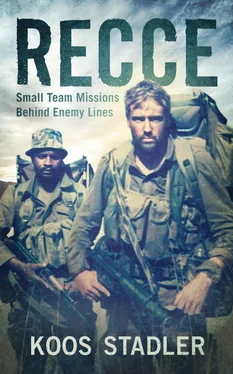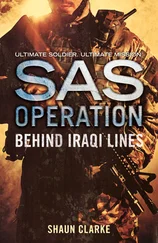The next part of our strategy involved a mind game that I eventually became very good at, a type of positive self-talk where I not only envisaged success but also started living the euphoria of completing the job successfully – a kind of visualising oneself as a James Bond (sadly without the martinis and the girls!) and thinking of the success as being the result of your efforts. At the risk of becoming an egotistical, over-confident prick, I started applying this technique in everyday life and found it most helpful in building self-confidence.
After the course in Pretoria, I took some time off and visited my folks for a few days. While at home in Upington I received a message to call Diedies urgently.
“The big one’s on,” Diedies said. “I need you here.”
He was, of course, talking about Lubango.
“How much time do I have?” I asked.
“Be at the HQ in a week,” he said. “I’ll meet you there. We’ll get an Int update first.”
My immediate response was to go on a three-day solo hike along the Orange River. I had to prepare myself mentally. Of course my mom couldn’t understand why I came home for a holiday only to disappear into the rough on a solitary adventure.
The operation was not going to be easy. At the time Lubango was considered the best-protected airfield in Angola. The Soviet-manned radar and anti-air systems would detect any aircraft approaching from as far away as 80 km, depending on its altitude. Just to get close to it would be a challenge in itself, never mind getting past the Cuban, FAPLA and SWAPO deployments surrounding it. The penetration would require meticulous planning and pinpoint navigation – and an exceptional level of skill and determination. The mission would also take no less than three to four weeks to complete.
I hitched a ride with friends who farmed on the South West African side of the Orange River – in the same rough and rocky terrain where, years before, the International got stuck on the mountainside and I had to walk to get help. I made my way down the deep ravines to the river, and then hiked along the beautiful Orange River gorge in an easterly direction towards Augrabies Falls. It was a harsh environment, but being alone in that wide-open and unspoilt world was exhilarating. That first night I slept under an overhanging rock with the dark and ominous water of the Great Gariep rushing by just a few metres from me. The rugged edges of the mountains towered above me on both sides of the river. It was a lonely and desolate stretch of earth.
On the third day I crossed the river to the South African side, where my dad picked me up. Two days later my car was packed and I was ready to join André Diedericks for our excursion to Lubango. It would turn out to be the experience of a lifetime.
Diedies had chosen his most trusted team for the job. A three-man team was needed for the target and so José da Costa had been pulled in as the third man. Boet Swart would be the mission commander in the Tac HQ at Ondangwa, Dave Scales in charge of signals, and Dave Drew was the intelligence officer. Even the helicopter crews from 19 Squadron were the cream of the crop: two stalwarts, Commandant John Church and Captain Gees Basson, would pilot the two Pumas.
We would infiltrate by helicopter to the mountains southwest of the target, then move on foot towards Lubango along a route straddling the highest ridges. Da Costa would remain on the high ground immediately southwest of the town to maintain comms or initiate emergency procedures, while Diedies and I would penetrate the airfield. Once on the apron where the aircraft were parked, we would split up and each work our way down the two lanes of MiGs.
The intelligence presented to us in Pretoria covered everything in the greatest detail. The positions of the FAPLA, Cuban and SWAPO deployments were meticulously plotted. With the assistance of the aerial photo interpreters, we “flew” every inch of the infiltration route, utilising the fancy stereoscopes. We plotted a primary LZ and some alternatives for rappelling from the helicopters. In the end I had mind-walked a hundred times the route I was to navigate. We even mapped out most of our lying-up places. We knew the layout of the target so intimately I could almost have done the operation blindfolded.
With the experts from EMLC, we did revision of the Tiller charges, once again going through the arming procedure and safety measures.
Soon we were off to Phalaborwa to prepare and rehearse. Diedies and I jacked up our knowledge of Portuguese phrases and again spent many hours rehearsing on the runway of Hoedspruit air base in the dark hours of the night. We became such masters at the art of stalking that I was actually looking forward to the exhilarating adrenaline rush on the night of the penetration. I had not entirely overcome my fear, but at least it was more contained and I now knew how to channel it.
The operational team did final touch-ups and spent the last three days in Pretoria, mostly fattening up and briefing HQ on the final plan. I used the time to work through my “fear-control” plan with Johnny Koortzen. He made me talk through the rehearsals and describe how we had mastered the stalking techniques. I had to explain how good our equipment was and how well prepared we were. After these sessions, and once I’d worked through the “self-talk” techniques, I could imagine nothing but success. Mentally, I was as prepared for the operation as I could ever be.
The sessions with Johnny had the added advantage that they would help Small Team operators in future. I noted down all the techniques and later captured them in a staff paper that would be incorporated in Small Team training manuals. In this way I compiled a series of lessons on so-called soft issues under headings such as “Self-motivation during small team operations”, “Control of fear and panic”, “Compiling a diet for long-term deployments” and a range of other aspects not covered in conventional training manuals.
While I was riding the crest of the wave in my professional life, the same could not be said about my personal life. Zelda wanted a bigger commitment, but I wasn’t ready for a more serious relationship. We loved spending time together, but life at 5 Recce was fast and frenetic and I wasn’t ready to settle down yet. She sensed my wavering, but never challenged me with an ultimatum.
The uncertain status of our relationship was disconcerting, especially since, at that time, I needed the reassurance that things were okay back home. However, the situation was entirely the result of my own immaturity. I simply didn’t have the skills to handle it.
For both of us, breaking up was an extremely emotional experience. We were at a resort outside Pretoria, enjoying each other’s company and whiling away the hours. I was intent on ending the relationship, as I was about to depart on my most dangerous mission thus far. I was afraid of not coming back to her, and didn’t want her to sit and wait for me. Without my knowing, Zelda had bought me a pullover as a gift – a sort of truce to initiate a new beginning in our relationship. However, she sensed what was about to happen and gave me the present before I could say anything.
There was a powerful emotional connection between us, and we felt a mutual attachment that, I had to admit, although it came too late to rebuild the relationship, may have been love. In the end, we parted that day without bringing the relationship to a decisive end, but both of us knew the coming mission would be a watershed. We wanted to be close to each other, but my decision not to commit made it impossible.
While I was trying to untangle myself from my relationship with Zelda, Diedies was by now a married man. Of course, I used the opportunity to give him a hard time for bending his own rules by getting married, especially without my consent. His wife, Rietjie, had been appointed communications officer at 5 Recce and lived in Phalaborwa. Although she did not have direct access to the latest intelligence or the team’s movements, she still worked closely enough with the intelligence section to have a fairly good idea of what was happening. This of course didn’t make things easier for Diedies.
Читать дальше












